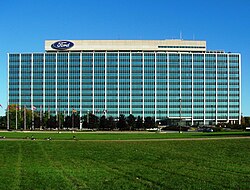Wayne County, Michigan
Wayne County is a county in the U.S. state of Michigan. As of the 2020 census, 1,793,561 people lived there,[3] and it was the 19th most-populous county in the United States. The county seat is Detroit[4] which is the largest city in Michigan.[1]
 Location in Michigan | |
| Country | United States |
| State | Michigan |
| Region | Metro Detroit |
| Incorporated | 1796 (created) 1815 (organized)[1][2] |
| Named for | Anthony Wayne |
| County seat and Largest city | Detroit |
| Area | |
| • Total | 673 sq mi (1,740 km2) |
| • Land | 612 sq mi (1,590 km2) |
| • Water | 61 sq mi (160 km2) |
| Population (2020)[3] | |
| • Total | 1,793,561 |
| • Density | 2,931/sq mi (1,132/km2) |
| Time zone | UTC−5 (Eastern Time Zone) |
| • Summer (DST) | UTC−4 (Eastern Daylight Time) |
| Website | www |
History
| Historical populations | |||
|---|---|---|---|
| Census | Pop. | %± | |
| 1810 | 2,227 | ||
| 1820 | 3,574 | 60.5% | |
| 1830 | 6,781 | 89.7% | |
| 1840 | 24,173 | 256.5% | |
| 1850 | 42,756 | 76.9% | |
| 1860 | 75,547 | 76.7% | |
| 1870 | 119,068 | 57.6% | |
| 1880 | 168,444 | 41.5% | |
| 1890 | 257,114 | 52.6% | |
| 1900 | 348,793 | 35.7% | |
| 1910 | 531,591 | 52.4% | |
| 1920 | 1,177,645 | 121.5% | |
| 1930 | 1,888,946 | 60.4% | |
| 1940 | 2,015,623 | 6.7% | |
| 1950 | 2,435,235 | 20.8% | |
| 1960 | 2,666,297 | 9.5% | |
| 1970 | 2,666,751 | 0.0% | |
| 1980 | 2,337,891 | −12.3% | |
| 1990 | 2,111,687 | −9.7% | |
| 2000 | 2,061,162 | −2.4% | |
| 2010 | 1,820,584 | −11.7% | |
| U.S. Decennial Census[5] | |||
Wayne County was one of the first counties formed when the Northwest Territory was created. It was named for the American general "Mad Anthony" Wayne. When it was created, the entire area of the Lower Peninsula of Michigan and small sections that are now part of northern Ohio, Indiana and Illinois were part of Wayne County. On August 15, 1796, the boundaries of Wayne County were set to begin at the mouth of the Cuyahoga River then west to Fort Wayne, then to the southernmost point of Lake Michigan and along the western shore north to the territorial boundary in Lake Superior and then along the territorial boundary through Lake Huron, Lake St. Clair, and Lake Erie back to the starting point.[6]
On January 14, 1803, the Governor of Indiana Territory, William Henry Harrison, changed the boundary. This new boundary included Chicago, Illinois and a large strip of Wisconsin along Lake Michigan.[7]
These boundaries were later changed again when Indiana and Illinois became states and as other counties were created in Michigan Territory.
Geography
The county has a total area of 672.20 square miles (1,741.0 km2). Of this, 614.15 square miles (1,590.6 km2) (or 91.36%) is land and 58.05 square miles (150.3 km2) (or 8.64%) is water[8] Parts of the Detroit River and Lake St. Clair are included in the county.
The eastern boundary is a water boundary in the Detroit River and Lake St. Clair with Essex County, Ontario, Canada. Cars crosses this boundary at the Detroit-Windsor Tunnel and the Ambassador Bridge.
Grosse Ile is the largest island in Wayne County. It is connected to the mainland by the Wayne County Bridge and the Grosse Ile Toll Bridge.
Adjacent counties
Cities, villages, and townships
Cities
|
Townships
Wayne County, Michigan Media
Original Wayne County of the Northwest Territory
The historic Guardian Building in Detroit is the Wayne County headquarters.
References
- ↑ 1.0 1.1 "Bibliography on Wayne County". Clarke Historical Library, Central Michigan University. Archived from the original on October 6, 2014. Retrieved January 23, 2013.
- ↑ "Wayne County, Michigan History Magazine". Archived from the original on May 13, 2006.
- ↑ 3.0 3.1 "Wayne County, Michigan". United States Census Bureau. Retrieved August 7, 2023.
- ↑ "Find a County". National Association of Counties. Retrieved 2008-01-31.
- ↑ "U.S. Decennial Census". Census.gov. Retrieved March 17, 2013.
- ↑ "Proclamation by Winthrop Sargent". Collections of the Pioneer Society of the State of Michigan together with Reports of County Pioneer Societies, Vol VIII (second ed.). Lansing, Mich.: Wynkoop Hallenbeck Crawford. 1907 [1886]. pp. 496–497. Retrieved 2006-10-15.
- ↑ "Proclamation by Governor Harrison". Collections of the Pioneer Society of the State of Michigan together with Reports of County Pioneer Societies, Vol VIII (second ed.). Lansing, Mich.: Wynkoop Hallenbeck Crawford. 1907 [1886]. pp. 540–542. Retrieved 2006-10-15.
- ↑ "Census 2000 U.S. Gazetteer Files: Counties". United States Census. Retrieved 2011-02-13.
Other websites
- Wayne County Government
- Wayne County Local History
- "Bibliography on Wayne County". Clarke Historical Library, Central Michigan University. Retrieved January 23, 2013.
- History of the Wayne County Road Commission Archived 2012-11-01 at the Wayback Machine
- Wayne County Road Commission Photos
- History: Facts about the World's First Mile of Concrete Highway Archived 2012-11-01 at the Wayback Machine
















